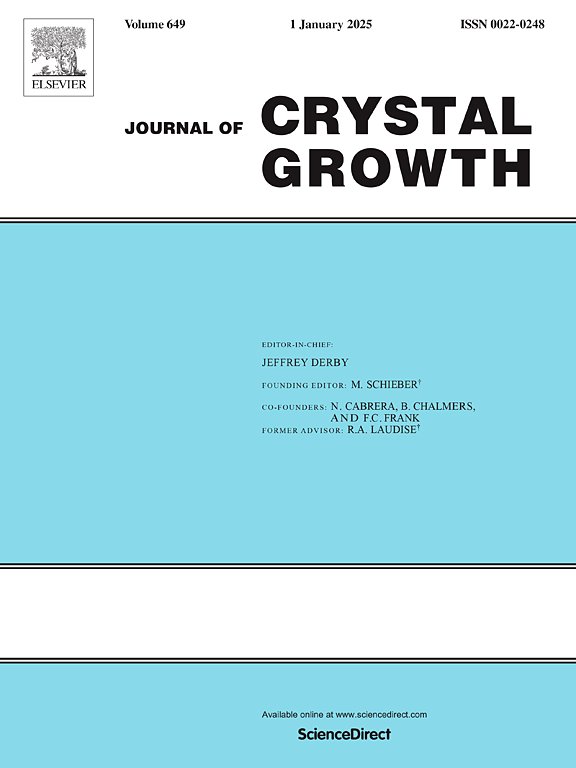基于响应面法快速预测晶体生长过程中的界面形态和氧气运输
IF 1.7
4区 材料科学
Q3 CRYSTALLOGRAPHY
引用次数: 0
摘要
本文建立了一个受气体剪切效应和热马兰戈尼效应影响的二维(2D)轴对称模型。结果表明,在晶体生长过程中,拉速、气体流速、坩埚和晶体旋转率等生长条件对晶体的界面形态和氧输送行为起着重要的决定作用。提出了一种基于克里金的响应面方法(RSM)来快速预测晶体生长行为,表明界面形态和氧浓度的输出可以通过相应的输入生长条件来预测。通过全局灵敏度分析,发现拉速是决定界面形态的关键因素,而气体流速和坩埚旋转速率对氧气输送的影响更大。此外,这两个敏感度最高的输入被用来构建响应面和预测未知的氧气输送。与数值模拟相比,所提出的模型被证明是减少测量时间和提高晶体行为预测准确性的有效工具。我们的研究结果为理解不同生长条件下的晶体生长过程提供了重要见解,并为晶体生长预测的数据驱动方法提供了灵感。本文章由计算机程序翻译,如有差异,请以英文原文为准。
Rapid prediction of interface morphology and oxygen transportation in crystal growth based on the response surface method
In this paper, a two-dimensional (2D) axisymmetric model subjected to the gas shear effect and thermal Marangoni effect is developed. It is highlighted that the growth conditions of pulling rate, gas flow rate, crucible, and crystal rotation rates play important roles in determining the crystal behaviors of interface morphology and oxygen transportation during the crystal growth process. A Kriging-based response surface method (RSM) is proposed to rapidly predict the crystal growth behaviors, indicating that the outputs of interface morphology and oxygen concentration can be predicted by the corresponding input growth conditions. By global sensitivity analysis, the pulling rate is identified as the key factor in determining the interface morphology, while gas flow rate and crucible rotation rate have a greater effect on oxygen transportation. Furthermore, these two inputs with the highest sensitivities are used to construct the response surface and predict unknown oxygen transportation. When compared with the numerical simulations, the presented model proves to be an effective tool for reducing measurement time and improving accuracy in predicting crystal behaviors. Our findings provide important insights into understanding the crystal growth process under different growth conditions and inspire a data-driven method for crystal growth prediction.
求助全文
通过发布文献求助,成功后即可免费获取论文全文。
去求助
来源期刊

Journal of Crystal Growth
化学-晶体学
CiteScore
3.60
自引率
11.10%
发文量
373
审稿时长
65 days
期刊介绍:
The journal offers a common reference and publication source for workers engaged in research on the experimental and theoretical aspects of crystal growth and its applications, e.g. in devices. Experimental and theoretical contributions are published in the following fields: theory of nucleation and growth, molecular kinetics and transport phenomena, crystallization in viscous media such as polymers and glasses; crystal growth of metals, minerals, semiconductors, superconductors, magnetics, inorganic, organic and biological substances in bulk or as thin films; molecular beam epitaxy, chemical vapor deposition, growth of III-V and II-VI and other semiconductors; characterization of single crystals by physical and chemical methods; apparatus, instrumentation and techniques for crystal growth, and purification methods; multilayer heterostructures and their characterisation with an emphasis on crystal growth and epitaxial aspects of electronic materials. A special feature of the journal is the periodic inclusion of proceedings of symposia and conferences on relevant aspects of crystal growth.
 求助内容:
求助内容: 应助结果提醒方式:
应助结果提醒方式:


